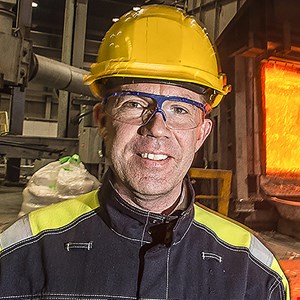Energy consumption halved thanks to oxyfuel combustion
A halving of energy consumption, temperatures that are more even, and a better working environment. These are just a few of the results achieved at Finspång by using oxyfuel combustion rather than air combustion in the blast furnaces.
Finspång has traditionally used either electricity or air combustion to heat up the blast furnaces used in production. Electric power was a good option in the 1950s and 60s when electricity was cheap in Sweden. But when the price began to rise during the 1980s, the electric furnaces were supplemented with new fuel-fired blast furnaces. These featured regenerative burners in which exhaust gases were used to preheat the air used in combustion, resulting in greater efficiency.
Anders Johansson, Senior Advisor for Process Technology within Strategic R&D at Finspång explains the situation changed again in the 1990s. “When new tougher regulations for nitrogen oxide emissions were introduced in Sweden, we decided to invest in rebuilding the air combustions furnaces for use with oxyfuel combustion instead,” he says.
Cleaner combustion with oxyfuel
Oxyfuel combustion is currently used quite broadly across the aluminium industry and is also used in the production of stainless steel and glass. The technology involves burning oxygen and methane/propane to produce a flame temperature in excess of 2,000 degrees C.
“In this way, you get cleaner combustion,” says Johansson. “It’s not necessary to introduce nitrogen into the combustion, which generates flue gases and nitrogen oxide emissions. And an added bonus was that we also got a better working environment when we stopped having to clean the ceramic media beds in the regenerative burners.”
Aluminium melted down much faster
Other advantages of oxyfuel combustion include that the temperature in the furnace becomes more even and that the melting down of the aluminium metal is achieved faster. The oven also requires less maintenance, which means that the operating costs are diminished.
“Critics of oxyfuel combustion sometimes point out that oxygen is expensive, but we believe the many advantages outweigh the disadvantages,” says Johansson.
Finspång’s oxyfuel blast furnaces
M0146 (installed in 1990).
Capacity: 27 tonnes.
Melting rate: Six tonnes per hour.
Burner power: 4 MW.
Energy consumption: 550 kWh/tonne.
M0144 (installed 2012)
Capacity: 40 tonnes.
Melting rate: Eight tonnes per hour.
Burner power: 7 MW.
Energy consumption: 650 kWh/ton.
Highest permitted temperature in the furnaces: 1,250 degrees C.
Measured nitrogen oxide emissions: between 50 and 80 mg/MJ (well below the EU’s limit of 100 mg/MJ).

New blast furnace for oxyfuel combustion
During 2012, Finspång installed an additional blast furnace for oxyfuel combustion, and the technology has proved to be a stroke of luck for the facility. Energy consumption per molten tonne of aluminium is now between 550 and 650 kWh compared to between 800 and 1,200 kWh per tonne for traditional air combustion.
“Halving energy consumption means that we save five to eight million Swedish crowns per year through lowered energy costs,” says Johansson
Energy consumption curve steadily declining
Thanks to the efforts of Johansson, his colleagues, and the gas company AGA in continuously improving and fine-tuning processes, the energy consumption curve has gone steadily down in recent years.
”Our long-term goal is to come down to 500 kWh per molten tonne with both the oxyfuel furnaces,” says Johansson.

 svenska
svenska
 中文(中华人民共和国)
中文(中华人民共和国)





